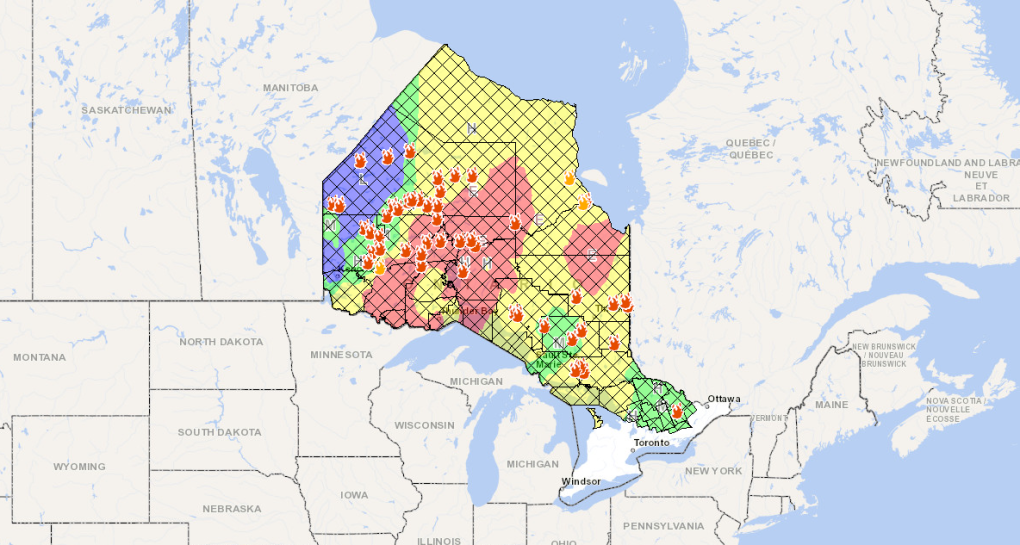Most of Ontario remains under fire bans with 3 times as many wildfires reported in 2023
Most of Ontario remains under a provincial fire ban, with three times as many wildfires reported in 2023 compared to the same time period last year.
According to the Ministry of Natural Resources and Forestry, there were 54 active wildland fires in Ontario as of early Saturday evening, including four new fires.
Since the beginning of the fire season, provincial data shows crews have fought at least 269 blazes, more than triple those seen in the same time period in 2022, in which 82 fires were reported.
Officials with the Canadian Interagency Forest Fire Centre (CIFFC) confirmed to CTV News Toronto that while Ontario has not received any interprovincial or international aid in fighting the fires so far, they do expect a deployment from Mexico on Monday.
- Download our app to get local alerts on your device
- Get the latest local updates right to your inbox
A provincial map shows the majority of the province is within a Restricted Fire Zone (RFZ) as a result of the wildfires. Open fires and the burning of grass or debris are temporarily banned in these areas.
Most regions north of Highway 7 are within a RFZ, with much of northern Ontario labelled as having a high or extreme risk of forest fires.
As such, many provincial parks have banned campfires, and residents are being told not to use fire pits or charcoal barbecues.
Southern Ontario is not under a RFZ, however some municipalities may choose to put their own fire bans in place as a precaution.
 This map shows Ontario's Restricted Fire Zones as of June 18.
This map shows Ontario's Restricted Fire Zones as of June 18.
In Saturday’s report by the CIFFC, officials say the bans have made a difference, however fires are continuing to spread.
“New starts have slowed over the last few days, due to a reprieve from fresh lightning and the implementation of the restricted fire zone,” the report reads.
“Existing fires continue to put on growth. Expect fire behaviour on the east side of the province to pick up as a new drying trend begins.”
According to the CIFFC, about 85,909 hectares have burned in Ontario in 2023 compared to the 2,337 hectares from the same months in 2022.
Of the fires noted by the CIFFC from April to June—which includes 275 fires—about 102 were caused by humans while another 173 were naturally caused.
Earlier this month, Premier Doug Ford urged residents not to light campfires in an effort to prevent further blazes from starting.
"I'm asking every Ontarian: please do not light any campfires," Ford said. "We're out there, all the firefighters are out there I should say, fighting against these wildfires ... we will throw every resource we can to make sure we put these fires out."
However, experts say it’s more than just human responsibility, and that climate change is playing a large part in the spread of fires.
Tanzina Mohsin, assistant professor in the Department of Physical and Environmental Sciences at the University of Toronto, told CTV News Toronto earlier this month that rising temperatures are a “key factor” in the increase of fires.
"This is basically drying our forests and causing it to burn more,” she said.
“We are creating a thirsty atmosphere and this is pulling water out of our plants and that is causing our vegetation to be dryer than normal, and then you see these forest fires are spreading quicker.”
Provincial data notes the 10-year average of forest fires for this time period is 195.
CTVNews.ca Top Stories

'It's a giant mess': Confusion remains about the GST/HST holiday
The organization representing small and medium size businesses in Canada says the start to the GST and HST holiday has been 'a giant mess.'
Donald Trump says Canada becoming 51st U.S. state is 'a great idea.' Jean Charest calls the comment a 'wake-up call'
U.S. President-elect Donald Trump is taking aim at Canada once more, saying it would be 'a great idea' to make it America's ‘51st state.'
'You're either with Beijing or you're with Washington': Ford says to Mexico in CNN interview
Ontario Premier Doug Ford has a message for Mexico as the threat of tariffs by incoming president Donald Trump hangs over both sides of the U.S. border.
'Why would I box myself in?: Singh on why he won't commit to helping bring Trudeau's gov't down, yet
NDP Leader Jagmeet Singh says U.S. president-elect Donald Trump's looming tariff threat is part of the reason why he's not committing to voting non-confidence in Prime Minister Justin Trudeau's government.
NEW Here's how the cost of living challenges are shaking up Canadian seniors' retirement plans
With the high cost of living increasingly a concern, some seniors are making sacrifices to help their adult children and grandchildren make ends meet. Here are some of their stories.
B.C. man drops camera into ocean, accidentally captures 'breathtaking' whale video
Before it turned into an extraordinary day, Peter Mieras says it began being quite ordinary.
What's the best treatment for ADHD? Large new study offers clues
Stimulant medications and certain therapies are more effective in treating ADHD symptoms than placebos, a new study on more than 14,000 adults has found.
Chicago man visits Michigan to return overdue book after 50 years
A Chicago man is trying to turn his honest mistake into something positive after forgetting to return an overdue library book to his childhood library in Warren.
There are 88 new Order of Canada appointees. Here's a look at some of the most notable names
Ryan Reynolds, Scott Oake and Maureen Ann Jennings are among the 88 new recipients of the Order of Canada.
































